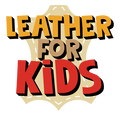Leather for Kids Store
-
The Concept
Leather for Kids creates DIY leather kits—the first of their kind—that blend education with play and turn children into Little Leather Artisans. Each kit follows a STEAM approach, introducing leather as an organic material while sparking creativity, problem-solving, and interactive learning. With no sharp tools or sewing required, the kits are safe, fun, and inspired by the simplicity of building toys—making sustainability and craftsmanship an adventure.
The Experience
Each kit comes with pre-cut leather pieces designed to form 2D and 3D modules. These can be assembled into themed collectibles or unique items for personal use. Every piece becomes something children can proudly use, share, or display.
Who It’s For
These DIY kits are made for children aged 5 and up—ideal for curious creators who enjoy making and exploring materials.
The Goal
Our goal is to spark curiosity and, consequently, understanding about leather while encouraging kids to create, explore, and problem-solve. By making and learning, kids grow into confident little artisans—while having fun along the way!
- Choosing a selection results in a full page refresh.



























